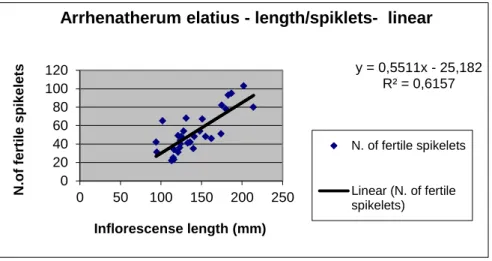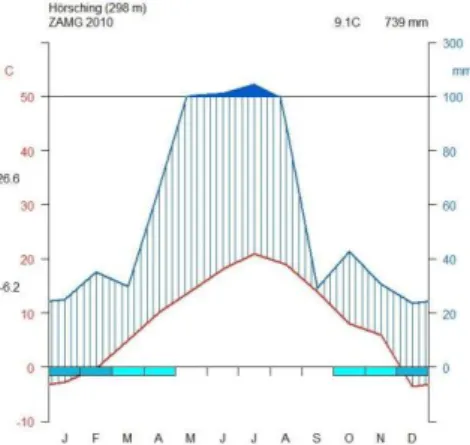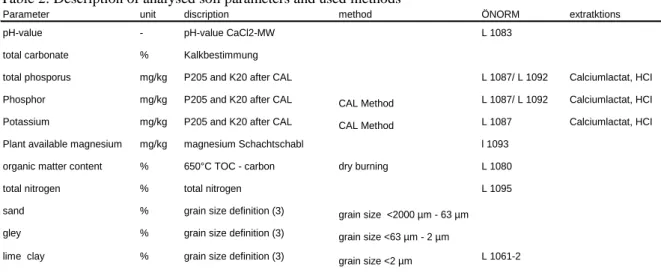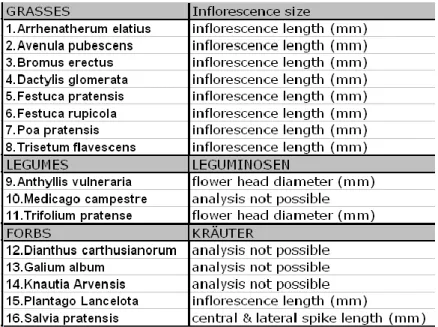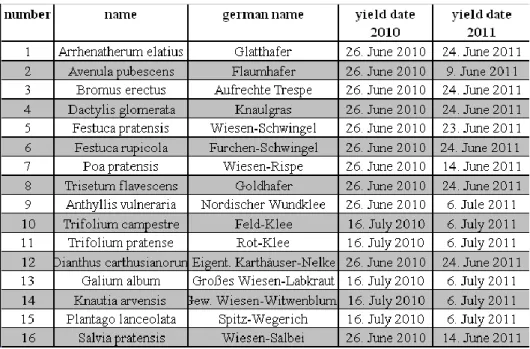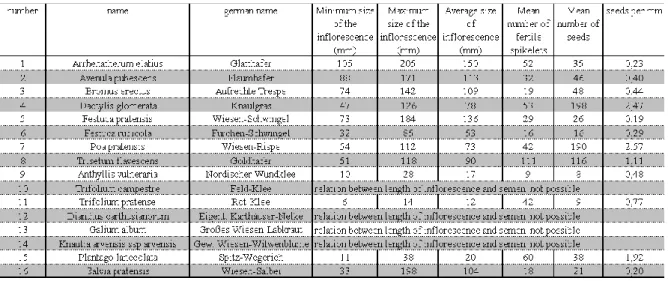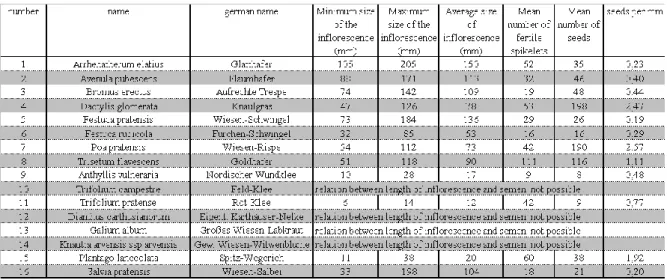The overall objective of work package 4 is the assessment of the potential and the real seed production of important species of grassland and sum the fertile stems and the number of seeds per stem in a limited area.
M EADOW CONSIDERED - W ELSER H EIDE
- General description of the donor sites
- Climate
- Yearly meteorology
- Soil survey of the donor site
- Species considered at the donor site Welser Heide
The diagrams start with January in the left corner of the diagram for the Northern Hemisphere and July for the Southern Hemisphere respectively. The diagram shows mean daily minimum temperatures below zero in black bars below the horizontal line (Heinrich Walter and Lieth Helmut, 1967). Figures 4 and 5 show the annual climate, mean temperature and precipitation of the Hörsching weather stations near the Welser Heide donor area in 2009 and 2010.
Soil from the study sites Arrhenatherion was collected and analyzed in 2009 and 2011 to determine its physical and chemical properties and its fertility. On the 31st of June 2009, the soil depth on the Arrhenatherion meadow was measured 5 times in each plot, the results can be found in table 1. Due to the history of the Welser Heide which was originally a gravel terrace landscape, the soil depth is low. .
Soil samples of the Welser Heide donor site were collected in two layers (0-10 cm and 10-20 cm) and analyzed in the laboratory. The grain size between sand and clay is about 40% to 45% which is in a good balance and typical of semi-arid communities. A high proportion of grain size between <2000 µm to 63 µm has a low nutrient content, low water holding capacity, intensive soil aeration and easy processing (Blum, 1992).
The organic matter content is measured in percentages and the soil falls into the category of strong humus (> 6.6 %) (BMLFUW, 2006).

A NALYSIS OF FERTILE STEMS AT SEED MATURATION
D ATE OF COLLECTION AT THE DONOR SITE W ELSER H EIDE
A NALYSES AND RESULTS OF THE FERTILE STEMS
A NALYSIS AND THE R ESULTS OF THE FERTILE STEM DENSITY
P HENOLOGICAL SURVEY OF THE W ELSER H EIDE
The seed production quantifications such as community, locality, meadow, climate, soil and management, species and collection of fertile stems at seed maturity are described in the final report 4.1.
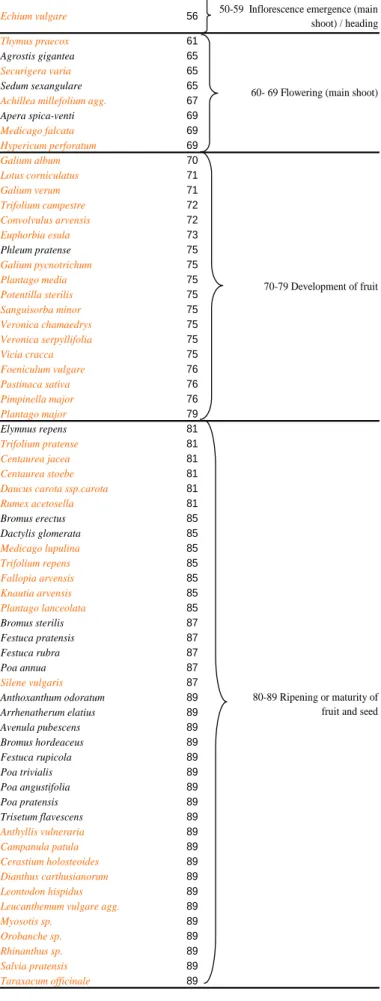
S EPARATION OF THE MATURE SEEDS
A SSESSMENT OF THOUSAND SEED WEIGHT (TSW)
Thousandseed weight differs between the years 2010 through 2011 among all species, some grasses had a higher TSW in the year 2011 (e.g. Arrhenaterium elatius, Avenula pubescens) compared to 2010 and some grasses had a lower TSW (e.g. Festuca pratensis, Poa pratensis). The leguminosae comparison shows a higher TSW in 2010, the forbs show a higher TSW in 2010 compared to 2011, except Dianthus carthusianorum and Knautia arvensis.
A SSESSMENT OF SEED SIZE
A SSESSMENT OF SEED GERMINABILITY
Results of seed germination capacity
The results in table 3 show that in 57% of the cases the germination rate was too low according to the ISTA rules (ISTA 2011). In 2011, the germination rate of some species (Arrhenatherum elatius, Avenula pubescens, Bromus erectus, Dactylis glomerata, Poa pratensis, Anthyllis vulneraria, Galium album, Salvia pratensis) is higher than in 2010, some species show a lower germination rate ( Festuca pratensis, Trisetum flavescens , Trifolium pratense, Dianthus carthusianorum, Knautia arvensis, Plantago lancelota).
P HENOLOGICAL SURVEY OF THE CONSIDERED SPECIES
Results Phenological survey Welser Heide 2010
Results Phenological survey Welser Heide 2011
C ONSIDERATION OF SEED PRODUCTION AND QUALITY
C ONSIDERATION OF THE FERTILE STEMS DENSITY
C ONSTRUCTION OF THE MODEL
This is probably due to the fact that in nature not all seeds are falling at the same time. Some plants have already lost a lot and some have lost no seed at the harvest date. The results of the correlation coefficient in the exponential regressions for Arrenatherum elatius are not as good as with the linear regression (Figure 3).
This means that in the case of Arrenatherum elatius the exponential regression shows better results regarding correlation than the linear regression. Similar to the linear regression, the correlation between the inflorescence length and the fertile spikelets shows better results than the correlation between the inflorescence length and the seed. The potential and the actual seed production of single fertile stems of the important species from the donor site Welser Heide do not really show a correlation, because the ripe seeds fell out of the fertile stems of different species.
The value - seeds per millimeter provides a simple way to estimate the seed yield of a specific site by extrapolating the results of measuring inflorescence size in a trial field to the entire site. The poor shape of the Arrhenatherion donor site Welser Heide produces a low density of fertile stems compared to the results of Scotton et al. Seed size also varies over the years, but no trend is apparent.
A high amount of species (close to 2/3) do not reach the germination capacity according to the International rules of seed testing (ISTA 2011) and the differences between the years show no trend. The statistics with the linear and exponential regressions were made from the data to estimate the standing seed yield (model). For each species on the plot, the phenological data will be reviewed according to the modified BBCH scale.
On harvest day, all fertile stems will be collected and analyzed for their size and seed amounts on the collected fertile stems. The standing seed yield will be calculated with the model to compare the model production with the amounts obtained from the collected fertile stems. The results of the phonological data show that not all species are mature at the same time and that it is important where it is possible to harvest at different times, in general the grasses produce the mature seeds earlier than the legumes and forages.
